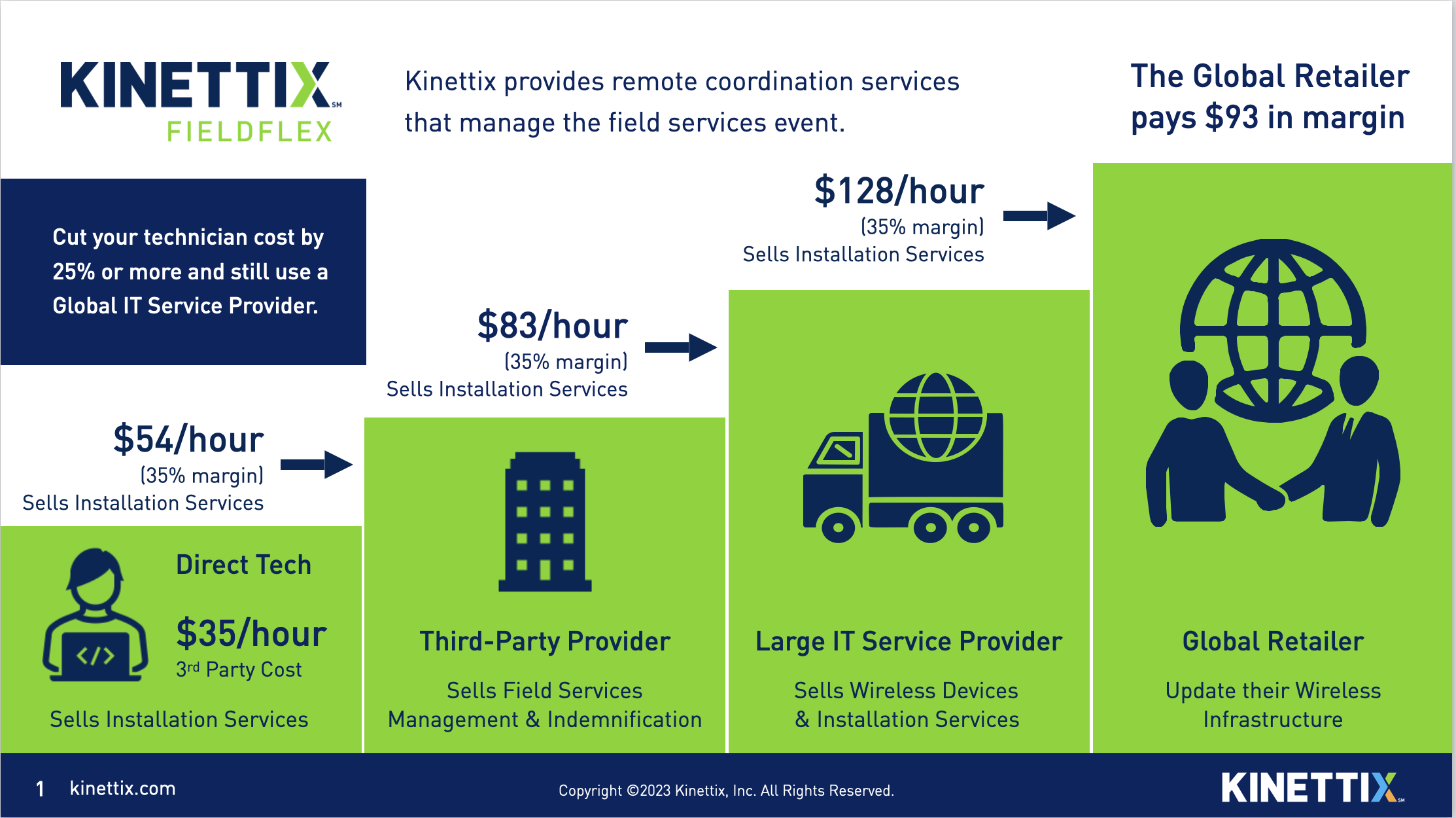In today’s fast-paced and competitive field service landscape, we are facing a significant challenge that needs immediate attention: margin stacking! As we strive to meet the evolving demands of our clients and stay ahead of the curve, we must confront the impact of margin stack on our profitability and sustainability.
Margin stacking not only increases spending, but it can also create an unclear scope and lower the quality of work. Ultimately, it can hurt a company's growth and scalability, making it harder to adapt to changes or disruptions in the industry.
Businesses can mitigate margin stacking by engaging technicians directly via platforms like Work Market and Field Nation. These techs, however, still require extensive coordination. That is where Kinettix’s FieldFlexSM service offering comes in.
Remote services, like those offered through Kinettix’s FieldFlex, are a type of field services augmentation that enables your organization to increase margins and manage its labor pool more effectively.
What Is Margin Stacking?
Margin stacking is the accumulation of costs from multiple layers of subcontractors that significantly increase the cost of services and lower profit margins. When using third-party technicians for IT deployment projects, margin stacking can find its way into your operation and cause headaches. The graphic below demonstrates this phenomenon.

To tackle margin stacking head-on, we need to take a direct approach to streamline our operations, optimizing resource utilization, and leveraging the latest technology to achieve better visibility of resources to reduce our costs. Here are some strategies to help overcome the margin stack.
Audit Current Projects
Complete a review of all your current projects and identify the number of levels of margin stacking. As illustrated above, every provider organization engaged in delivering the service will be one level of margin stack.
For most people, it is enlightening to find out how many third-party resources are being engaged to deliver an outcome. There can be anywhere from two to five levels of organizations that get a revenue cut. That is how technician costs can go from $54 per hour to $128 per hour.
Utilize Local Resources
For all new projects, locate local technicians that can meet the requirements and perform the scope of work. You can use platforms like Field Nation and Work Market to locate and utilize IT field technicians. Or you may have your own team of field technicians that can be leveraged to complete the work.
If you have not previously engaged IT field technicians directly, this will require that you take a different approach to service delivery. Rather than relying on a third-party provider to handle the entire field service event and deliver an outcome, you will be coordinating and managing the event and engaging directly with the field technician. While you will materially increase your profit margin, you will need to engage coordination resources to handle the management of the work.
Consider Combining Preventative Maintenance & Project Work
Realize that dispatch and short-term projects often have the highest hourly rates. If you have ongoing preventative maintenance and/or low-priority dispatch work, it can save a great deal of money if you can combine this work with the project work that you are doing.
The more notice and flexibility you can have with scheduling technicians, the lower the cost. Last-minute projects or critical dispatch work often drives the price up significantly. By working with technicians directly on an ongoing basis, you develop good relationships with them that can afford you the best hourly rate or, even better, fixed rates.
Work With Providers Closest to the Resources
While utilizing local technicians is one part of the cost reduction strategy, there may be times when you cannot contract directly with an individual technician due to co-employment risks, insurance requirements, or payment requirements. In that scenario, you may need to work with a provider partner to successfully engage that labor.
Regardless of the reason, you still want to be as close to the technicians as possible. So rather than working with a national IT service provider, you work with a regional company that is localized to the work site. If they employ the technicians on a W2 basis, you will only have one markup. If they are subcontracted with the local company, there will be two markups in the price but it will still keep the cost much lower than going through a national provider.
With this strategy in mind, Kinettix is here to ease the challenge of moving your service delivery model to engage with IT field technicians directly. We are excited to leverage our decades of IT field services experience by developing revolutionary FieldFlex services for our customers.
Benefits of Going Direct-to-Tech
A great way to mitigate margin stacking is to employ a direct-to-tech model and invest in field services augmentation. Working directly with your technicians instead of dealing with multiple layers of outsourcing comes with many benefits.
Reduced costs
Going direct-to-tech can be more cost-effective than hiring full-time employees or relying on multiple subcontractors. Since you are cutting out excess layers of subcontractors, your organization can avoid the adverse effects of margin stacking and enjoy more significant cost savings.
Faster time to market
Besides margin stacking, you can avoid many common recruiting slowdowns by directly contacting the technician and leveraging field services augmentation services. As a result, recruiting, onboarding, and deploying your own field services technicians give your business a competitive edge and a faster time to market.
Improved quality of work
A direct-to-tech approach to field services augmentation ensures that the right people with the necessary skills are assigned to their projects. Since your organization is working closer to field technicians, your project benefits from more direct and effective communication. Ultimately, this leads to higher-quality work and greater customer satisfaction.
FieldFlexSM Remote Services & Field Services Augmentation
Going direct-to-tech is an excellent way to increase margins, but this approach has its drawbacks. Managing and coordinating a growing team of field service technicians is challenging and time-consuming. To achieve successful outcomes, you need an effective IT project coordinator to manage your tech pool.
This is where Kinettix’s FieldFlex comes in. FieldFlex is a field services augmentation program that provides professional IT project coordination to ensure that your company gets the best possible results from your contingent workforce.
Margin stacking can be a major stumbling block to field services augmentation, but it's one that you can mitigate with the right approach. Going direct-to-tech and leveraging the benefits of FieldFlex helps your business increase margins, improve project quality, and accelerate time to market. If you are looking for a reliable partner to help you navigate the complexities of IT field services, contact Kinettix today.






